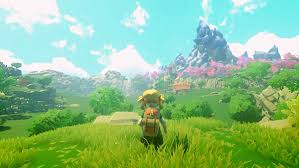General game information
Game name: Yonder: The Cloud Catcher Chronicles
Release date: July 18, 2017
Price: US$ 24.99
Available on: Steam
Genre: Open world adventure
Developer: Prideful Sloth
Publisher: Prideful Sloth
Opencritic: Here
Launch trailer
Introduction
While videogames nowadays are far more colorful and interesting than the brown shooters that dominated the industry a few years ago, it’s still hard to find “feel good” titles that only focus on the positive aspects of life, daring to fully abandon violence as a gameplay mechanic. Yonder: The Cloud Catcher Chronicles is one of these rare releases, an open world adventure game that places us in a beautiful island teeming with collectibles, friendly animals and villagers in need.
Setting, story and characters

As we travel through the island of Gemea we’ll meet a number of quirky characters who’ll either help us or ask for our services. They are not voiced, and their characterization is usually limited to a few lines of dialogue and the way they are dressed, but there are a few standouts who have their own small questlines. A bit more work could have gone in this aspect of Yonder, as I couldn’t help but feel that most of the islanders were just mannequins, standing there to provide a sense of scale and nothing else.
The island itself is not only beautiful, but also quite diverse, and we’ll visit green fields, sandy deserts and snowy mountains as we try to discover the source of the Murk. A day/night cycle and a weather system help to maintain the illusion that Gemea is a living, breathing world, and we’ll often meet friendly animals as they graze on the green fields or run through the snow.
Gameplay
Clearing the shadow that threatens Gemea will take most players at least five hours of exploration, resource gathering, crafting and farming. Along the way, we’ll have to discover small, fairy-like creatures called Sprites (who are invisible to everyone but us) and their powers will let us clean places affected by the shadowy Murk, unlocking new paths or allowing access to hidden chests and collectibles. Some Sprites will not come with us unless we solve a puzzle, or bring them a specific item, while others will instantly take the chance to jump into our backpack as we interact with the location they’ve chosen as a hiding spot.
Aside from the Sprite mechanic, most of our time with Yonder will be spent gathering resources and learning how to craft new trinkets to help Gemea’s inhabitants. Within the first hour, we’ll get access to different tools such as an axe, a fishing rod and a hammer (among others) and with them firmly secured in our backpack, we’ll be able to obtain wood, ores, stones, etc.

Quests are similarly straightforward, as we’ll usually have to obtain a number of doodads and then deliver them to the NPC who requested our help. A few questlines don’t fall into this category, sending us on detective adventures, or asking us to solve a puzzle, but most of the time we’ll be doing the classic “bring me X amount of Y resource” MMO-type quest. I’m not a fan of that type of activity, and I think that the game would have been a lot better with less fetch quests, even if that means it’d be shorter.

Another nice touch that I had a great deal of fun playing with was the customization system, which lets players find and equip different clothing elements, as well as hairstyles and hair colors. It may not be as deep as the mechanics on offer in other titles, but it does its job marvelously.
Graphics, sound and performance

Audio wise, Yonder fares similarly well. The soundtrack fits the gorgeous atmosphere to a T, and whoever was in charge of sound FX did an excellent job with the environmental audio tracks.
Conclusion

7/10 (Good)

